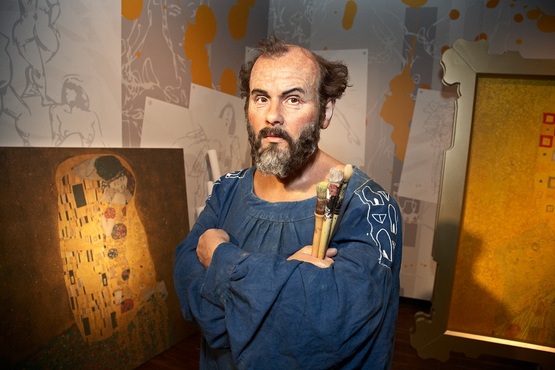 |
 |
|
Painted during the peak of his modernist era in 1907-1908, Gustav Klimt's "The Kiss" earned its moniker not only due to the prevalent yellow tones but also owing to his frequent use of gold leaf in his artworks. Influenced by his father's trade as a jeweler, Klimt's affinity for gold engraving was cultivated since childhood. Continue reading our article in collaboration with yantar.ua and learn more about the characteristics and interesting facts about this work of art.
The Concept Behind Klimt's Artwork"The Kiss" portrays an intimate embrace between a man and a woman, seemingly melding into a radiant yellow patch. While the man leans in for a kiss, the woman, though reciprocating the embrace, averts her gaze. She closes her eyes and kneels before him, symbolizing submission. The attire of the couple, characterized by vibrant hues, highlights the man's sophisticated garments with a strict color scheme in contrast to the woman's attire. Positioned against the backdrop of a flower-covered cliff, the woman's dress appears to blend seamlessly into the cliff's vegetation. The abstract, shimmering background serves to accentuate the central figures without detracting from their intimacy. "The Kiss" by Gustav Klimt: The Genesis of a Masterpiece"The Kiss" stands as one of Gustav Klimt's most renowned works, representing a pivotal juncture in his artistic journey and garnering widespread acclaim in the art world. Delving into the origins of this celebrated painting unveils a captivating narrative. Executed between 1907 and 1908, the creation of "The Kiss" coincided with a crucial phase in Klimt's career. Commissioned by a nobleman for a portrait featuring himself and his beloved sharing a kiss, Klimt received a medallion featuring the lady's likeness to guide his depiction. While the patron approved of the final composition, he expressed reservations about the lovers' lips not meeting. Klimt, however, aimed to convey the emotional essence and longing for intimacy rather than mere physical contact. Intriguingly, Klimt later confessed to developing feelings for the woman depicted in the medallion, explaining his reluctance to depict her engaged in a kiss with another man. Whether factual or anecdotal, this revelation adds layers of complexity to the painting's narrative, which endures to this day.
Klimt's Amber "The Kiss"Adorned with intricately encrusted amber, "The Kiss" captivates viewers with its luminosity and depth. The addition of amber accents complements the gold leaf, enhancing the image's radiance. A reproduction of this masterpiece serves as a unique and heartfelt gift, symbolizing enduring affection and adding an original touch to any interior décor.
|
|
|

 Amber Depiction: Gustav Klimt's "The Kiss"
Amber Depiction: Gustav Klimt's "The Kiss"
